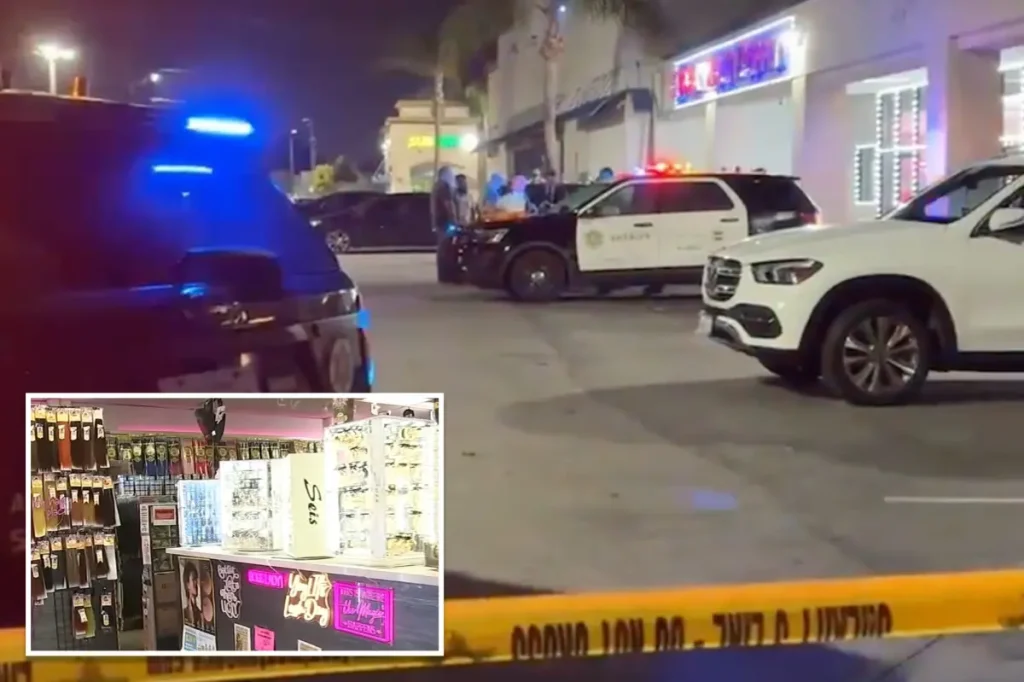Customer’s Act of Self-Defense Leaves Community Shaken: A Deep Dive into the Compton Beauty Store Shooting
In a tense and disturbing incident that unfolded at Pink Beauty Supply in Compton last Sunday afternoon, what began as routine shopping escalated into a fatal confrontation that has left the local community reexamining notions of safety, self-defense, and public conduct. Around 3:30 PM, Los Angeles County Sheriff’s deputies responded to reports of a shooting at the store, where they discovered a deceased 42-year-old man. According to official accounts and witness statements, the man had entered the establishment and begun exhibiting increasingly threatening behavior—first by following and groping a female customer, then by verbally threatening everyone present, and finally by damaging merchandise. As the situation deteriorated, store employees and customers reported seeing what they believed was a knife in his hand, accompanied by explicit threats to “kill and harm everyone in the store.” The escalating danger prompted another female customer to draw a legally carried firearm, first firing a warning shot, and then—when the man allegedly charged at her—firing a second, fatal shot that authorities are currently investigating as a possible act of self-defense.
The aftermath has revealed a complex picture of both the deceased man and the circumstances surrounding the shooting. Though officials have not publicly identified him, local media reports describe him as an individual with possible gang affiliations and a troubling criminal history that included previous assaults, robberies, and thefts. The woman who fired the shots has not been arrested and is reportedly cooperating fully with investigators as the Los Angeles County District Attorney’s office reviews the case to determine whether any charges are warranted. Surveillance footage confirms that multiple customers were present during the altercation, potentially substantiating accounts of the threatening behavior that preceded the shooting. One witness, speaking to local media while requesting anonymity, praised the armed customer’s actions as “brave,” expressing relief that someone had intervened in a potentially dangerous situation that could have harmed others, including children who frequently visit the store. “I’m glad that the woman that did it was brave enough to even go and do something like that to save somebody else,” the witness told KABC.
However, the incident has generated mixed reactions among community members familiar with the beauty supply store, which has long been considered a safe, friendly establishment in the neighborhood. Regular patrons like Almond Le Joice expressed shock at the violence erupting in such an unexpected location, questioning why such an incident would occur there. Another frequent shopper, Melody Johnson, voiced concern about the armed customer, telling CBS Los Angeles, “I’m glad nobody else got hurt, but for her to walk in here and have a weapon, that’s concerning.” This ambivalence reflects broader societal tensions around concealed carry practices and armed self-defense—while some view the woman’s actions as heroic protection of herself and others against an imminent threat, others worry about the normalization of firearms in everyday spaces and the potential for escalation that their presence might create. The incident has thus become a focal point for ongoing debates about personal safety, community protection, and the appropriate response to public threats.
The shooting occurs against the backdrop of Compton’s complicated relationship with violent crime. Currently ranked ninth among America’s deadliest cities according to the Center for Public Safety Initiatives, the city has nonetheless seen encouraging trends in recent years. Data from the Los Angeles County Sheriff’s Department indicates an 8% reduction in violent crime—particularly homicides—over the past year. This improvement suggests that while public safety remains a significant concern for residents, progress is being made in addressing systemic issues of violence. The Pink Beauty Supply incident thus represents both a troubling reminder of persistent threats and a complex case study in civilian responses to those threats. The apparent presence of multiple witnesses and surveillance footage may provide investigators with a clearer picture of the sequence of events and help determine whether the use of deadly force was justified under California’s self-defense laws.
The human elements of this case extend beyond the legal questions to touch on issues of trauma and community healing. For the employees and customers who witnessed the confrontation and shooting, the psychological impact may be lasting. Similarly, the woman who fired the fatal shots now faces not only potential legal scrutiny but also the emotional and psychological consequences of having taken a life, even if ultimately deemed justified. The beauty supply store itself—described by regular customers as a longstanding community fixture—must now navigate both the physical aftermath of damaged merchandise and the intangible effects of being the site of a violent death. These ripple effects highlight how incidents of public violence create trauma that extends far beyond the immediate participants, affecting the sense of safety and well-being throughout a community. Support services and community dialogue may prove essential in processing this collective experience.
As this case moves forward through the investigative process, it serves as a sobering reminder of how quickly everyday situations can escalate to life-or-death confrontations. The alleged perpetrator’s progression from inappropriate touching to verbal threats to apparent physical aggression represents a pattern of escalation that security experts and violence prevention specialists often identify as precursors to more serious violence. The armed customer’s decision to first fire a warning shot before using deadly force suggests an attempt at de-escalation that, according to preliminary accounts, was met with continued aggression. This sequence raises important questions about threat assessment, proportional response, and the split-second decisions individuals must make when faced with perceived imminent danger. Whatever the final legal determination may be, this incident illuminates the complex intersection of personal responsibility, community safety, and the persistent challenges of violence prevention in urban America. For the residents of Compton and communities facing similar challenges nationwide, the path forward involves both practical security measures and deeper engagement with the social factors that contribute to public violence.


